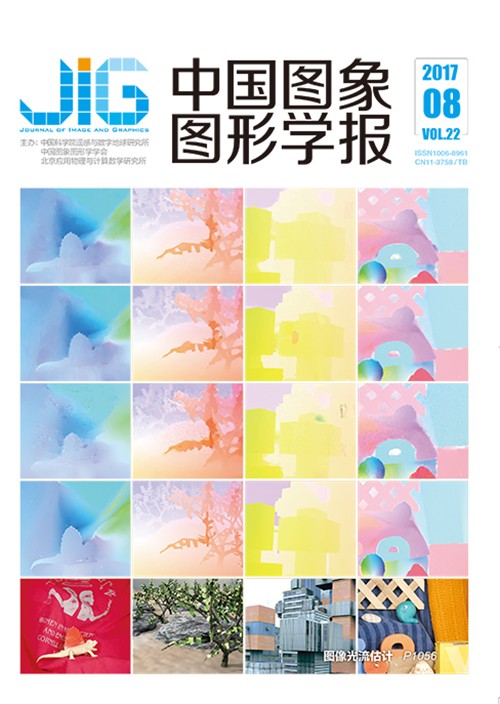
利用格式塔的高分辨率遥感影像建筑物提取
摘 要
目的 格式塔心理学的理论基础为通过对事物的部分感知,实现对事物整体的认识。本文将该思想应用到建筑物提取中,提出一种兼顾目标细节及整体几何特征的高分辨率遥感影像建筑物提取方法。方法 首先,利用SIFT算法提取特征点作为候选边缘点;然后定义格式塔序列连续性原则判别边缘点,从而得到边缘点点集;并由边缘点点集拟合边缘,实现遥感影像建筑物提取。结果 利用提出算法,对WorldView-2遥感影像进行建筑物提取实验。通过与基于多尺度分割和区域合并的建筑物提取算法对比可以看出,提出算法能够更加准确、完整地提取出建筑物。采用分支因子、遗漏因子、检测率和完整性4个定量化指标对实验结果的定量评价,本文算法的检测率和完整性均大于对比算法,且本文算法的检测率均在95%以上,验证了提出基于格式塔理论的高分辨率遥感影像建筑物提取算法的有效性和准确性。结论 基于格式塔的高分辨率遥感影像建筑物提取算法能够准确刻画建筑物细节特征,同时兼顾建筑物整体几何轮廓,准确提取高分辨率遥感影像中的建筑物。本文算法针对高分辨率遥感影像,适用于提取边缘具有直线特征的建筑物。使用本文算法进行遥感影像建筑物提取时,提取精度会随分辨率降低而降低,建议实验影像分辨率在5 m以上。
关键词
Building extraction from high resolution remote sensing image by using Gestalt
Li Qing, Li Yu, Wang Yu, Zhao Quanhua(Institute for Remote Sensing Science and Application, School of Geomatics, Liaoning Technical University, Fuxin 123000, China) Abstract
Objective Gestalt is a psychology term that means unified whole. This term refers to the theory which describes how people tend to group visual elements when certain principles are fulfilled. Gestalt concludes principles, such as similarity, row continuation, proximity, and closure, which are based on the overall cognition of an object which can be obtained through perceiving its parts. However, quantizing these principles in mathematics is difficult in practice because they are abstract psychology concepts. Actually, only few principles, such as similarity and proximity, are used in the literature, and these principles are interpreted in a simple way. Building extraction based on Gestalt laws is challenging and demanding. In this paper, the idea of Gestalt is applied to designing a building extraction algorithm from remote sensing image by testing the candidate edge points, defining the relationship of edge points according to Gestalt principles, finding the edge points, and fitting edges of buildings. This paper proposes a new method for extracting buildings from high resolution remote sensing image based on Gestalt rules. Method First, the scale invariant feature transform algorithm is used to extract the key points as candidate edge points in a given remote sensing image, wherein each key point is respectively attributed with features, such as position, orientation, scale, and assessment. Gestalt space, which is a 4-D domain containing the preceding features mentioned, is established, and the subsequent operations are completed in the space. The Gestalt principle known as row continuation determines whether or not all candidate edge points are on the edges of buildings. Each candidate edge point involved in the operation is regarded as an integral Gestalt, and a new integral Gestalt is obtained after the operation according to the principle of row continuation. If the assessment of the new integral Gestalt is larger than the given threshold, then the integral Gestalts, namely the candidate edge points involved in operation, fulfill the rule of row continuation and are all on the edges of buildings. Consequently, the set of edge points can be obtained. Finally, the edges of buildings are fitted with different sets of edge points, and silhouettes of buildings are formed by combining their extracted edges. Result Experiments are carried on with the WorldView-2 images compared with other building extraction algorithms, such as mean shift algorithm, multi-scale segmentation, and region merge-based building extraction algorithm to quantitatively and qualitatively test the proposed method. The proposed method can better correctly and completely extract the buildings from the image. We use the evaluation measures extensively accepted for building extraction to quantify the accuracy of the building extraction results. The extracted buildings and manually delineated buildings are compared pixel-by-pixel. All pixel in the image are categorized into four types: true positive(TP), manual and automated methods label the pixel belonging to the buildings; true negative(TN), manual and automated methods label the pixel belonging to the background; false positive(FP), the automated method incorrectly labels the pixel as belonging to a building; false negative(FN), the automated method incorrectly labels a pixel truly belonging to a building. The number of pixels that fall into each of the four categories mentioned are determined. In addition, the branching factor(BF), miss factor(MF), detection percentage(DP), and quality percentage(QP) are computed. The BF is a measure of the commission error in which the system incorrectly labels background pixels as buildings. The MF measures the omission error in which the system incorrectly labels building pixels as background. The DP denotes the percentage of building pixels correctly labeled by the automated process. The QP measures the absolute quality of the extraction and is the most stringent measure. The DP and QP of the proposed method are greater than the comparison method, and all DP of the proposed method is greater than 95%. The proposed method is more accurate than other building extraction methods. Moreover, all experiments demonstrate the feasibility and effectiveness of the proposed method. Conclusion Experimental results show that the proposed method can well extract the buildings from high resolution remote sensing image. Thus, the proposed method is demonstrated to be a feasible and effective method for building extraction. For remote sensing images, the proposed method is suitable for edge extraction with linear features of the building on an image. The accuracy will be decreased with low resolution when the proposed method is used for building extraction. Therefore, the suggested resolution of the experimental image is above five meters.
Keywords
gestalt building extraction scale invariant feature transform(SIFT) algorithm row continuation edge extraction
|



 中国图象图形学报 │ 京ICP备05080539号-4 │ 本系统由
中国图象图形学报 │ 京ICP备05080539号-4 │ 本系统由